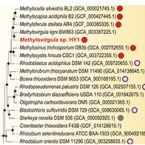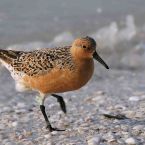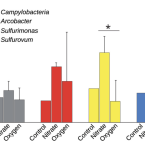Publications
Publications in peer reviewed journals
Sulfur and methane oxidation by a single microorganism.
2022 - Proc Natl Acad Sci U S A, 32: e2114799119
Abstract:
Natural and anthropogenic wetlands are major sources of the atmospheric greenhouse gas methane. Methane emissions from wetlands are mitigated by methanotrophic bacteria at the oxic-anoxic interface, a zone of intense redox cycling of carbon, sulfur, and nitrogen compounds. Here, we report on the isolation of an aerobic methanotrophic bacterium, '' strain HY1, which possesses metabolic capabilities never before found in any methanotroph. Most notably, strain HY1 is the first bacterium shown to aerobically oxidize both methane and reduced sulfur compounds for growth. Genomic and proteomic analyses showed that soluble methane monooxygenase and XoxF-type alcohol dehydrogenases are responsible for methane and methanol oxidation, respectively. Various pathways for respiratory sulfur oxidation were present, including the Sox-rDsr pathway and the SI system. Strain HY1 employed the Calvin-Benson-Bassham cycle for CO fixation during chemolithoautotrophic growth on reduced sulfur compounds. Proteomic and microrespirometry analyses showed that the metabolic pathways for methane and thiosulfate oxidation were induced in the presence of the respective substrates. Methane and thiosulfate could therefore be independently or simultaneously oxidized. The discovery of this versatile bacterium demonstrates that methanotrophy and thiotrophy are compatible in a single microorganism and underpins the intimate interactions of methane and sulfur cycles in oxic-anoxic interface environments.
Sulfur in lucinid bivalves inhibits intake rates of a molluscivore shorebird
2022 - Oecologia, in press
Abstract:
A forager’s energy intake rate is usually constrained by a combination of handling time, encounter rate and digestion rate. On top of that, food intake may be constrained when a forager can only process a maximum amount of certain toxic compounds. The latter constraint is well described for herbivores with a limited tolerance to plant secondary metabolites. In sulfidic marine ecosystems, many animals host chemoautotrophic endosymbionts, which store sulfur compounds as an energy resource, potentially making their hosts toxic to predators. The red knot Calidris canutus canutus is a molluscivore shorebird that winters on the mudflats of Banc d’Arguin, where the most abundant bivalve prey Loripes orbiculatus hosts sulfide-oxidizing bacteria. In this system, we studied the potential effect of sulfur on the red knots’ intake rates, by offering Loripes with various sulfur content to captive birds. To manipulate toxicity, we starved Loripes for 10 days by removing them from their symbiont’s energy source sulfide. As predicted, we found lower sulfur concentrations in starved Loripes. We also included natural variation in sulfur concentrations by offering Loripes collected at two different locations. In both cases lower sulfur levels in Loripes resulted in higher consumption rates in red knots. Over time the red knots increased their intake rates on Loripes, showing their ability to adjust to a higher intake of sulfur.
Genus-specific carbon fixation activity measurements reveal distinct responses to oxygen among hydrothermal vent Campylobacteria
2022 - Appl Environ Microbiol, 2: e0208321
Abstract:
Molecular surveys of low temperature deep-sea hydrothermal vent fluids have shown that Campylobacteria (previously Epsilonproteobacteria) often dominate the microbial community and that three genera, Arcobacter, Sulfurimonas, and Sulfurovum, frequently coexist. In this study, we used replicated radiocarbon incubations of deep-sea hydrothermal fluids to investigate activity of each genus under three experimental conditions. To quantify genus-specific radiocarbon incorporation, we used newly designed oligonucleotide probes for Arcobacter, Sulfurimonas, and Sulfurovum to quantify their activity using catalyzed-reporter deposition fluorescence in situhybridization (CARD-FISH) combined with fluorescence-activated cell sorting. All three genera actively fixed CO2 in short-term (∼ 20 h) incubations, but responded differently to the additions of nitrate and oxygen. Oxygen additions had the largest effect on community composition, and caused a pronounced shift in community composition at the amplicon sequence variant (ASV) level after only 20 h of incubation. The effect of oxygen on carbon fixation rates appeared to depend on the initial starting community. The presented results support the hypothesis that these chemoautotrophic genera possess functionally redundant core metabolic capabilities, but also reveal finer-scale differences in growth likely reflecting adaptation of physiologically-distinct phylotypes to varying oxygen concentrations in situ. Overall, our study provides new insights into how oxygen controls community composition and total chemoautotrophic activity, and underscores how quickly deep-sea vent microbial communities respond to disturbances. IMPORTANCE Sulfidic environments worldwide are often dominated by sulfur-oxidizing, carbon-fixing Campylobacteria. Environmental factors associated with this group's dominance are now understood, but far less is known about the ecology and physiology of members of subgroups of chemoautotrophic Campylobacteria. In this study, we used a novel method to differentiate the genus-specific chemoautotrophic activity of three subtypes of Campylobacteria. In combination with evidence from microscopic counts, chemical consumption/production during incubations, and DNA-based measurements, our data show that oxygen concentration affects both community composition and chemoautotrophic function in situ. These results help us better understand factors controlling microbial diversity at deep-sea hydrothermal vents, and provide first-order insights into the ecophysiological differences between these distinct microbial taxa.



